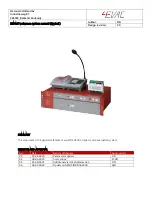
V1.0 2022 Copyright Safewaze
From OSHA 1926.502 and 1910.66
Anchorages used for attachment of personal fall arrest systems shall be independent of any anchorage being used to support or
suspend platforms, and capable of supporting at least 5,000 lbs (22.2 kN) per user attached, or be designed, installed, and used
as part of a complete personal fall arrest systems which maintains a safety factor of at least two, and is under the supervision of a
qualified person.
When using this equipment, employers
must create a rescue plan, and provide the means to implement the plan. This plan must
be communicated to equipment users, authorized persons, and rescuers. Rescue operations require specialized equipment
beyond the scope of this manual. See ANSI Z359.4-2013 for specific rescue information.
Safewaze D-ring Extenders are designed for the following weight capacities
(Maximum capacities include clothing, tools, and equipment):
ANSI Z359:
130-310 lbs max
OSHA: Up to 420 lbs max
6.3 INSPECTION FREQUENCY
6.4 RESCUE PLAN
6.0 LIMITATIONS & REQUIREMENTS
6.1 CAPACITY
When installing or using this equipment always refer to the following requirements and limitations:
6.2 ANCHORAGE
Anchorages selected for fall arrest systems shall have a strength capable of sustaining static loads applied in the directions
permitted by the system of at least:
1.
5,000 lbs. (22.2 kN) for non-certified anchorages, or
2.
Two times the maximum arresting force for certified anchorages.
When more than one fall arrest system is attached to an anchorage, the strengths set forth in (1) and (2) above shall be multiplied
by the number of systems attached to the anchorage.
NOTE
:
Special rescue measures may be required for a fall over an edge.
In order to ensure reduced fall distances, always attempt to anchor the connecting device directly overhead. Overhead anchoring
will limit free fall distance to a minimum. Be aware of workers sharing the workspace to avoid becoming tangled with another
worker. Steer clear of objects that could fall and impact a lifeline. The lifeline should never pass under the user’s arms or legs. A
lifeline should never be knotted, clamped, or be otherwise modified.
A Personal Fall Arrest System (PFAS) must utilize a Full Body Harness. Refer to Figure 1 of this manual for specific FBH D-ring
approved applications.
It is important to make sure that adequate clearance is available. Free Fall, Maximum Arrest Distance, Height of Worker, and
current clearance above the next fall hazard must all be considered in the Fall Clearance calculation.
6.5 FREE FALL
6.6 BODY SUPPORT
6.7 FALL CLEARANCE
6.8 DETERMINE MINIMUM REQUIRED FALL CLEARANCE
Either the Authorized Person (User), or the Rescuer must inspect this equipment before each use. Annual inspections must be
completed by a Competent Person other than the user. Results must be documented.
6



































